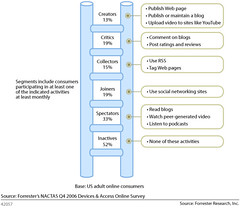The FASTForward blog continues to roll along, and I have to admit that there are still some good posts coming down the line. This recent post about innovation by Paula Thornton was almost perfect in challenging the assumption that Enterprise 2.0 is all about the technology - but then she says:
"Enterprise 2.0 provides necessary but insufficient means by which to facilitate the potential of individuals to innovate. The potential can easily surpass Knowledge Management initiatives, which were doomed by edict as a misnomer. There is no value in managing knowledge, an intert collection of bytes. The value is in facilitating human potential."
Unfortunately Thornton appears to be falling into her own hole by suggesting that Knowledge Management (KM) is all about managing bytes. That's a first generation KM idea that and no reflection of current ideas in this space. Now, I know I have said some of this before, but we should careful when try to compare Knowledge Management with Enterprise 2.0 and likewise Enterprise 2.0 with Intranets. In this respect its a little unfair of Thornton to pick on James Robertson's article about Building innovative intranets - I actually interpreted this as being about the concept of continuous improvement that needs to happen to keep an intranet relevant (something I've written about myself in The Search for the Perfect Intranet [PDF, 108KB]).
Getting back to Thornton's point - and she concludes that:
"I suggest that it is not Enterprise 2.0 that is threatened by this renaissance, it is the survival of the current IT model that is in question."
If I had one criticism of James' article (and my own for that, in hindsight) is that it still places responsibility for innovating the intranet with the "intranet team". In the words of Euan, if you are heading down the Enterprise 2.0 road then IT and intranet teams both need to learn how to get out of the way of the stuff that matters to the end users so they can innovate...
So here is a different perspective - rather than creating a wedge, what we really need is a way to bridge the gap between those focused on running IT and intranets with Enterprise 2.0.
In fact James Robertson has a second piece published at around the same time, Three fundamental purposes of an intranet, that reminded me of one of my favourite papers by Dick Stenmark, titled Information vs. Knowledge: The Role of intranets in Knowledge Management (PDF, 425KB). In this paper Stenmark introduces a "multi-perspective view of the intranet" consisting of information, awareness and communication (which he later expanded to include a fourth dimension, collaboration) - very similar to James' content, communication and activity idea. Stenmark concludes in this paper:
"When facilitating KM initiatives, information technology environments such as intranets may be utilised to establish a virtual meeting place where communities of practice can engage in dialogue and collaboration. Actions such as information creation, information seeking, and information interpretation can successfully be performed in these environments. To facilitate this, intranets must be design to support not only the informational aspects but also include people by making salient networks of users with similar interests and allow these to communicate and collaborate. I therefore argue the intranet must be viewed from both an information perspective, an awareness perspective, and a communication perspective."
From a management point of view, Knowledge Management, Innovation, Enterprise 2.0, even intranets and information technology are just tools used in organisations to achieve an end. Management helps us to frame these ideas in, dare I say, manageable chunks so we can understand and apply them. Its not perfect or holistic, but it is human. So Stenmark has helped to bridge the gap between intranets (information) and Knowledge Management. Can we do the same with Enterprise 2.0?
I think we can - add together Stenmark with recent concepts like McAfee's S.L.A.T.E.S., the Wisdom of the Crowds and earlier ideas like the Cluetrain Manifesto and even Tom Davenport's Human Centered Information Management then we have some pretty good bridge building resources in our management toolkit already.
And this brings me back to one of my questions, does how we do it matter more than what we do?
(Sorry, couldn't resist the tool metaphor...)
Technorati tags:
Paula Thornton,
James Robertson,
Innovation,
Enterprise 2.0,
Knowledge Management,
Dick Stenmark,
intranets,
Andrew McAfee,
Wisdom of the Crowds,
Tom Davenport,
Human Centered Information Management,
Cluetrain Manifesto
